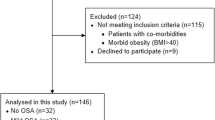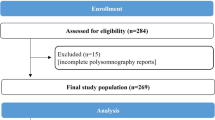Abstract
Background
Obstructive sleep apnea (OSA) is associated with increased oxidative stress. Certain essential trace minerals have shown to play an important role in the maintenance of redox homeostasis. We determined the concentrations of trace minerals in OSA patients and assessed their relationships to OSA severity as indicated by the apnea/hypopnea index (AHI).
Methods
We enrolled 44 patients with newly diagnosed mild to moderate OSA and 20 without OSA. The following parameters were measured: polysomnographic values of nocturnal sleep; plasma trace minerals zinc (Zn), copper (Cu), iron (Fe), and erythrocyte selenium (Se); oxidative stress status; and plasma high-sensitivity C-reactive protein (hs-CRP) and tumor necrosis factor-α (TNF-α).
Results
Compared to controls matched for age, gender, and body mass index, OSA patients had lower concentrations of plasma Zn and erythrocyte Se and higher plasma concentrations of Cu and Fe. OSA patients had significantly higher plasma concentrations of hs-CRP, TNF-α, and malondialdehyde (MDA), and lower erythrocyte antioxidant enzyme glutathione peroxidase (GPx) and superoxide dismutase activities. Significant differences in all the above parameters were also found in patients with moderate OSA compared to those with mild OSA. Furthermore, AHI values correlated significantly with neck circumference, GPx activity, and MDA, hs-CRP, and TNF-α concentrations in OSA patients. AHI values were also negatively associated with concentrations of plasma Zn and erythrocyte Se, but were positively linked to plasma concentrations of Fe and Cu.
Conclusions
Abnormal concentrations of these trace minerals may reflect oxidative damage and inflammatory response, thus increasing the severity of OSA.
Similar content being viewed by others
References
Daulatzai MA (2012) Quintessential risk factors: their role in promoting cognitive dysfunction and Alzheimer’s disease. Neurochem Res 37:2627–2658.
Jelic S, Le Jemtel TH (2008) Inflammation, oxidative stress, and the vascular endothelium in obstructive sleep apnea. Trends Cardiovasc Med 18:253–260.
Lam JC, Mak JC, Ip MS (2012) Obesity, obstructive sleep apnoea and metabolic syndrome. Respirology 17:223–236.
Del Ben M, Fabiani M, Loffredo L, Polimeni L, Carnevale R, Baratta F et al (2012) Oxidative stress mediated arterial dysfunction in patients with obstructive sleep apnoea and the effect of continuous positive airway pressure treatment. BMC Pulm Med 12:36.
Lui MM, Lam DC, Ip MS (2012) Significance of endothelial dysfunction in sleeprelated breathing disorder. Respirology. doi: 10.1111/j.1440-1843.2012.02212.x.
Gozal D, Kheirandish-Gozal L (2008) The multiple challenges of obstructive sleep apnea in children: morbidity and treatment. Curr Opin Pediatr 20:654–658.
Wysocka E, Cofta S, Piorunek T, Dziegielewska-Gesiak S, Bryl W, Torlinski L (2013) Blood antioxidant status, dysglycemia and obstructive sleep apnea. Adv Exp Med Biol 756:121–129.
Franco CM, Lima AM, Ataíde L Jr, Lins OG, Castro CM, Bezerra AA et al (2012) Obstructive sleep apnea severity correlates with cellular and plasma oxidative stress parameters and affective symptoms. J Mol Neurosci 47:300–310.
Mancuso M, Bonanni E, LoGerfo A, Orsucci D, Maestri M, Chico L et al (2012) Oxidative stress biomarkers in patients with untreated obstructive sleep apnea syndrome. Sleep Med 13:632–636.
Ntalapascha M, Makris D, Kyparos A, Tsilioni I, Kostikas K, Gourgoulianis K et al (2012) Oxidative stress in patients with obstructive sleep apnea syndrome. Sleep Breath. May 18. [Epub ahead of print]
Guo CH, Wang CL, Chen PC (2011a) Micronutrient metabolism in hemodialysis patients, Hemodialysis-different aspects, Maria Goretti Penido (ed.). InTech, pp 173–204.
Tinggi U (2008) Selenium: its role as antioxidant in human health. Environ Health Prev Med 13:102–108.
Chorostowska-Wynimko J, Kedzior ME (2008) Role of immune system in the pathomechanism of obstructive sleep apnea. Pneumonol Alergol Pol 76:101–110.
Kim J, Hakim F, Kheirandish-Gozal L, Gozal D (2011) Inflammatory pathways in children with insufficient or disordered sleep. Respir Physiol Neurobiol 178:465–474.
Johns MW (1991) A new method for measuring daytime sleepiness: the Epworth sleepiness scale. Sleep 14:540–545.
Rechtschaffen A, Kales A (1968) A manual of standardized terminology, techniques and scoring system of sleep stages in human subjects. Los Angeles: Brain Information Service/Brain Research Institute, University of California.
Guo CH, Liu PJ, Lin KP, Chen PC (2012) Nutritional supplement therapy improves oxidative stress, immune response, pulmonary function, and quality of life in allergic asthma patients- an open-label pilot study. Altern Med Revr 17:42–56.
Frank A (1976) Automated wet ashing and multi-metal determination in biological materials by atomic-absorption spectrometry. Fresenius Z Anal Chem 279:101–102.
Norheim G, Haugen A (1986) Precise determination of selenium in tissues using automated wet digestion and an automated hydride generator-atomic absorption spectroscopy system. Acta Pharmacol Toxicol 59(Suppl VII): 610–612.
Davies R J, Ali NJ, Stradling JR (1992) Neck circumference and other clinical features in the diagnosis of the obstructive sleep apnoea syndrome. Thorax 47:101–105.
Gruber A, Horwood F, Sithole J, Ali NJ, Idris I (2006) Obstructive sleep apnoea is in-dependently associated with the metabolic syndrome but not insulin resistance state. Cardiovasc Diabetol 5:22.
Imagawa S, Yamaguchi Y, Higuchi M, Neichi T, Hasegawa Y, Mukai HY et al (2001) Levels of vascular endothelial growth factor are elevated in patients with obstructive sleep apnea—hypopnea syndrome. Blood 98:1255–1257.
Yamauchi M, Nakano H, Maekawa J, Okamoto Y, Ohnishi Y, Suzuki T et al (2005) Oxidative stress in obstructive sleep apnea. Chest 127:1674–1679.
Baysal E, Taysi S, Aksoy N, Uyar M, Celenk E, Karatas ZA et al (2012) Serum paraoxonase, arylesterase activity and oxidative status in patients with obstructive sleep apnea syndrome (OSAS). Eur Rev Med Pharmacol Sci 16:770–774.
Lee SD, Ju G, Choi JA, Kim JW, Yoon IY (2012) The association of oxidative stress with central obesity in obstructive sleep apnea. Sleep Breath 16:511–517.
Yamauchi M, Kimura H (2008) Oxidative stress in obstructive sleep apnea: putative pathways to the cardiovascular complications. Antioxid Redox Signal 10:755–768.
Makris D, Ntalapascha M, Zakynthinos E (2012) The association between oxidative stress and obstructive sleep apnea syndrome. Sleep Breath [Epub ahead of print]
Lui MM, Lam JC, Mak HK, Xu A, Ooi C, Lam DC et al (2009) C-reactive protein is associated with obstructive sleep apnea independent of visceral obesity. Chest 135:950–956.
Bhushan B, Guleria R, Misra A, Pandey RM, Luthra K, Vikram NK (2009) Obstructive sleep apnoea correlates with C-reactive protein in obese Asian Indians. Nutr Metab Cardiovasc Dis 19:184–189.
Drummond M, Winck J, Guimarães J, Santos AC, Almeida J, Marques J (2009) Long term effect of autoadjusting positive airway pressure on C-reactive protein and interleukin-6 in men with obstructive sleep apnoea syndrome. Arch Bronconeumol 45:577–584.
Gozal D, Crabtree VM, Sans Capdevila O, Witcher LA, Kheirandish-Gozal L (2007) C-reactive protein, obstructive sleep apnea, and cognitive dysfunction in school-aged children. Am J Respir Crit Care Med 176:188–193.
Lavie L (2012) Oxidative stress inflammation and endothelial dysfunction in obstructive sleep apnea. Front Biosci 4:1391–1403.
Jomova K, Valko M (2011) Advances in metal-induced oxidative stress and human disease. Toxicology 283:65–87.
Ye J, Liu H, Li Y, Liu X, Zhu JM (2007) Increased serum levels of C-reactive protein and matrix metalloproteinase-9 in obstructive sleep apnea syndrome. Chin Med J 120:1482–1486.
Guo CH, Liu PJ, Hsia S, Chuang CJ, Chen PC (2011b) Role of certain trace minerals in oxidative stress, inflammation, CD4/CD8 lymphocyte ratios, and lung function in asthmatic patients. Ann Clin Biochem 48:344–351.
Pizent A, Pavlovic M, Jurasovic J, Dodig S, Pasalic D, Mujagic R (2010) Antioxidants, trace elements and metabolic syndrome in elderly subjects. J Nutr Health Aging 14: 866–871.
Ostrakhovitch EA, Lordnejad MR, Schliess F, Sies H, Klotz LO (2002) Copper ions strongly activate the phosphoinositide-3-Kinase/Akt pathway independent of the generation of reactive oxygen species. Arch Biochem Biophys 397:232–239.
Nanami M, Ookawara T, Otaki Y, Ito K, Moriguchi R, Miyagawa K et al (2005) Tumor necrosis factor-alpha-induced iron sequestration and oxidative stress in human endothelial cells. Arterioscler Thromb Vasc Biol 25:2495–2501.
Kalantar-Zadeh K, Mehrotra R, Fouque D, Kopple JD (2004) Metabolic acidosis and malnutrition-inflammation complex syndrome in chronic renal failure. Semin Dial 17: 455–465.
King JC (2000) Determinants of maternal zinc status during pregnancy. Am J Clin Nutr 71:1334s–1343s.
da Rocha JT, Sperança A, Nogueira CW, Zeni G (2009) Hypolipidaemic activity of orally administered diphenyl diselenide in Triton WR-1339-induced hyperlipidaemia in mice. J Pharm Pharmacol 61:1673–1679.
Liu H, Lu Q, Huang K (2010) Selenium suppressed hydrogen peroxide-induced vascular smooth muscle cells calcification through inhibiting oxidative stress and ERK activation. J Cell Biochem 111:1556–1564.
Walston J, Xue Q, Semba RD, Ferrucci L, Cappola AR, Ricks M et al (2006) Serum antioxidants, inflammation, and total mortality in older women. Am J Epidemiol 163:18–26.
Gasparian AV, Yao YJ, Lü J, Yemelyanov AY, Lyakh LA, Slaga TJ et al (2002) Selenium compounds inhibit I kappa B kinase (IKK) and nuclear factor-kappa B (NF-kappa B) in prostate cancer cells. Mol Cancer Ther 1:1079–1087.
Author information
Authors and Affiliations
Corresponding author
Rights and permissions
About this article
Cite this article
Chen, P.C., Guo, C.H., Tseng, C.J. et al. Blood trace minerals concentrations and oxidative stress in patients with obstructive sleep apnea. J Nutr Health Aging 17, 639–644 (2013). https://doi.org/10.1007/s12603-013-0023-x
Received:
Accepted:
Published:
Issue Date:
DOI: https://doi.org/10.1007/s12603-013-0023-x




